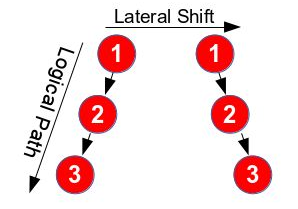As programmers, we are experts at logical thinking, and strive to find logic in everything and anything we do! After all, computers work only on logic, and nothing else will do! There are times when we get stuck in our thinking process and face a problem that we struggle to solve logically. Sometimes we don’t understand the problem at all, and at other times we fail to get a satisfactory logical answer in spite of having understood the problem.
The reason why we struggle in many of such cases is precisely because we are deep within a logical path that prevents us from escaping it and seeing the problem from a different angle! A logical path of thoughts is shown below. Observe that if we are in step 3, the most likely step we will take logically is step 4. It is very rare that we backtrack to step 2 and try out something else, especially if step 3 was the “most logical” step after step 2!
A solution in such cases is most likely possible using lateral thinking instead of logical thinking! So what is this lateral thinking?
 Wikipedia defines lateral thinking as “Lateral thinking is solving problems through an indirect and creative approach, using reasoning that is not immediately obvious and involving ideas that may not be obtainable by using only traditional step-by-step logic.” Let me simplify. Instead of continuing a train of thoughts deeper, lateral thinking makes you approach the problem with a different perspective or try out a fundamentally different possibility! This is illustrated in the diagram.
Wikipedia defines lateral thinking as “Lateral thinking is solving problems through an indirect and creative approach, using reasoning that is not immediately obvious and involving ideas that may not be obtainable by using only traditional step-by-step logic.” Let me simplify. Instead of continuing a train of thoughts deeper, lateral thinking makes you approach the problem with a different perspective or try out a fundamentally different possibility! This is illustrated in the diagram.
You might have heard some wise people tell that if you are faced with a problem that you are struggling to solve, just get a good night’s rest leaving the problem alone! In fact, some people may also advise that you take your mind off completely from the problem and maybe instead entertain yourself! The next day when you confront the problem, you magically see the solution form in front of you that you couldn’t think of earlier! Now, why does this happen? Because of a lateral shift in thinking, of course!
If you want a practical example of a lateral shift, here’s an article that I had originally read in Readers Digest many years back:
A complaint was received by the Pontiac Division of General Motors:
“This is the second time I have written you, and I don’t blame you for not answering me, because I kind of sounded crazy, but it is a fact that we have a tradition in our family of ice cream for dessert after dinner each night. But the kind of ice cream varies so, every night, after we’ve eaten, the whole family votes on which kind of ice cream we should have and I drive down to the store to get it. It’s also a fact that I recently purchased a new Pontiac and since then my trips to the store have created a problem. You see, every time I buy vanilla ice cream, when I start back from the store my car won’t start. If I get any other kind of ice cream, the car starts just fine. I want you to know I’m serious about this question, no matter how silly it sounds: ‘What is there about a Pontiac that makes it not start when I get vanilla ice cream, and easy to start whenever I get any other kind?'”The Pontiac President was understandably skeptical about the letter, but sent an engineer to check it out anyway. The latter was surprised to be greeted by a successful, obviously well educated man in a fine neighborhood. He had arranged to meet the man just after dinner time, so the two hopped into the car and drove to the ice cream store. It was vanilla ice cream that night and, sure enough, after they came back to the car, it wouldn’t start.
The engineer returned for three more nights. The first night, the man got chocolate. The car started. The second night, he got strawberry. The car started. The third night he ordered vanilla. The car failed to start.
Now the engineer, being a logical man, refused to believe that this man’s car was allergic to vanilla ice cream. He arranged, therefore, to continue his visits for as long as it took to solve the problem. And toward this end he began to take notes: he jotted down all sorts of data, time of day, type of gas used, time to drive back and forth, etc.
In a short time, he had a clue: the man took less time to buy vanilla than any other flavor. Why? The answer was in the layout of the store.
Vanilla, being the most popular flavor, was in a separate case at the front of the store for quick pickup. All the other flavors were kept in the back of the store at a different counter where it took considerably longer to find the flavor and get checked out.
Now the question for the engineer was why the car wouldn’t start when it took less time. Once time became the problem — not the vanilla ice cream — the engineer quickly came up with the answer: vapor lock. It was happening every night, but the extra time taken to get the other flavors allowed the engine to cool down sufficiently to start. When the man got vanilla, the engine was still too hot for the vapor lock to dissipate.
In the situation described above, it is logical for anyone to think of the connection between vanilla ice cream and the starting of the car, when there is none! It requires a lateral shift in thinking to realise that the issue here is the relationship between time and starting of the car, and of course there is a logical relationship between vanilla ice cream and time.
Lateral thinking does not replace logical thinking! Lateral thinking only makes you shift your logical thoughts from one sequence to another.
Periodically, I will add logical puzzles below that require some kind of a lateral shift in thinking in order to solve them! It will be fun solving them, and fun realising the lateral shift required!
Puzzle #1:
Solution:
Let’s number the switches for convenience. Switch on switches 1 and 2 and wait for some time (let’s say 10 minutes). Then switch off switch 1 and enter the room.
- If the light is on, then obviously the switch is switch #2 since that’s the only switch on now.
- Otherwise, touch the bulb. If it is hot, then the switch is switch #1 as it was on for some time!
- Otherwise, it has to be switch #3.
The lateral shift:
In the process of thinking logically, most people will concentrate only on light and ignore heat completely! Thinking of the heat generated because of the switching on of the bulb requires a lateral shift in thinking!
Puzzle #2:
Solution:
Let’s number the boxes for convenience. Pick 1 ball from box #1, 2 balls from box #2, 3 balls from box #3, and so on till you pick 10 balls from box #10. The total number of balls picked, therefore, will be 1+2+3+4+5+6+7+8+9+10=55. Now weigh all these balls on the scale. In the ideal case (if there were no defects), the weight would have been 550gm. But given the fact that one of the boxes contains defective balls, the weight will be lesser by 1 gm per ball. The number of grams by which the weight is lesser than the ideal weight of 550gm will tell us the box number of the defective balls, since we have taken different number of balls from each box!
The lateral shift:
Having seen these kind of problems, we are quick to decide how we will weigh the boxes, or 1 ball from each box. It requires a lateral shift in thinking to pick different number of balls from each box!
Puzzle #3:
Solution:
Logically, these are the choices in front of the girl:
1. The girl should refuse to take a pebble.
2. The girl should show that there were two black pebbles in the bag and expose the money-lender as a cheat.
3. The girl should pick a black pebble and sacrifice herself in order to save her father from his debt and imprisonment.
However, there is a way of ensuring a much better result than all these:
The girl put her hand in the moneybag and drew out a pebble. Without looking at it, she fumbled and let it fall into the pebble-strewn path where it immediately became lost among all the other pebbles. “Oh, how clumsy of me!” she said. “But never mind, if you look into the bag for the one that is left, you will be able to tell which pebble I picked.”
Since the remaining pebble is black, it must be assumed that she had picked the white one. And since the money-lender dared not admit his dishonesty, the girl changed what seemed an impossible situation into an extremely advantageous one.
The lateral shift:
Logical thinking sometimes confines us to a finite set of logical possibilities – beyond which we rarely think. Sometimes, there are better solutions outside of these constraints, and thinking of such ideas is exactly what is called “out of the box thinking“!





Related Articles
No user responded in this post